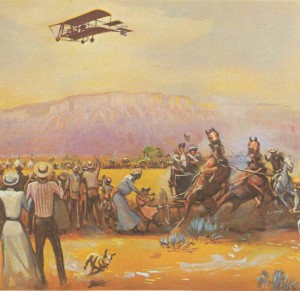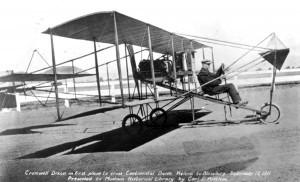By Jon Axline, Montana Department of Transportation
Montana’s greatest aviator was not from Montana at all. Indeed, he only spent three days in the Treasure State in late September 1911. But in those three days, 19 year-old Cromwell Dixon made an indelible mark on thousands of people in the state’s capitol city of Helena. His feat foreshadowed the Lindbergh-mania that swept Montana two decades later. Cromwell Dixon, the “Boy Aviator,” was the first man to fly across the Continental Divide.
On Nov. 3, 1904, 12-year-old Cromwell Dixon watched a demonstration of six sky cycles at the St. Louis International World Exposition. The devices consisted of a bicycle-like contraption suspended from a semi-rigid dirigible. The “pilot” operated it by pedaling the “bicycle,” which powered paddles that propelled the sky cycle through the sky. One of the pilots observed by Dixon in 1904 was a Montana rancher named Thomas “Chalk” Benbow.
A rancher in the foothills of the spectacular Beartooth Mountains of south central Montana, Benbow had been intrigued by flight for many years. In 1903, he designed his own sky cycle, which was powered by a 4-cylinder, air-cooled internal combustion engine. After displaying a model of his “Montana Meteor” in a Red Lodge saloon, Benbow formed the American Aerial Navigation Company and convinced several local entrepreneurs to invest $30,000 in the machine. Benbow built a full-scale version of the Meteor in 1903, and conducted the first test flights that same year.
Although Benbow’s flight during the 1904 exposition ended in failure when it became entangled in the wire enclosure of the exposition grounds, it intrigued young Cromwell Dixon to build his own sky cycle in 1906. His mother and sister helped him fabricate the balloon and sold tickets to his exhibitions of the device. After giving demonstrations in his hometown of Columbus, Ohio, Dixon took his act on the road. He was a popular sight at state fairs in Kentucky, Ohio and Pennsylvania for several years before he tired of his sky cycle and began looking for bigger thrills.
In 1911, Dixon gave up the sky cycle for the biplane. He took a three-day class at the Curtiss Aviation School in Hammondsport, N.Y., and was granted pilot’s license number 43 by the Aero Clubs of America on Aug. 11, 1911. At that time, he was the youngest aviator to hold a pilot’s license in the United States. Dixon signed on with the Curtiss Exhibition Company to fly at fairs and expositions as part of its demonstration team. The team was one way for pilots to pay for their aircraft. He acquired a Curtiss biplane that one pilot described as “its mother was an apple box and its father a roll of fence wire.” The Boy Aviator’s mother had to sign a waiver for Dixon to fly with the team as he was underage. The pilot soon developed the “Dixon Corkscrew” maneuver, which earned him a significant raise from the company. Less than a month after obtaining his license, Dixon arrived in Helena, Mont., where critics expected him to wow audiences with the “most daring maneuvers.” A charismatic individual, he dazzled the C
apitol City’s citizens.
Helena loved Cromwell Dixon. The lanky and handsome 19 year old made Helena’s teen-aged girls swoon. Men wanted to hang around with him because he represented the very best of young manhood. The Capitol City’s newspapers described him as warm-hearted, sunny-tempered, generous, wholesome, and “bubbling over with boyish mirth, to be with him was a pleasure.”

Cromwell Dixon, the 19-year-old “Boy Aviator,” was the first to cross the Continental Divide, winning the $10,000 prize.
The charismatic youth certainly pleased the crowds at the State Fair with his daring acrobatics. On September 28, he made three flights. In his second flight of the day, Dixon “plunged in a headlong flight straight downward a distance of several hundred feet, spiraled, corkscrewed, dipped and glided, actually turned semi-somersaults and ran through the gamut of the most dangerous and spectacular feats known to airmen.” His exploits helped draw record crowds to the ninth State Fair in Helena. After his second flight that day, Montana Governor Edwin L. Norris presented Dixon with an aerial barometer.
Undoubtedly, the goal of Dixon’s visit to the Queen City was not only to provide demonstrations of the Curtiss biplane, but also to attempt a crossing of the Continental Divide west of the city. Crossing the divide was long a goal of American aeronauts. Indeed, Dixon was originally one of three pilots scheduled to perform at the Montana State Fair. The other two, Eugene Ely and J. C. “Bud” Mars, had previously attempted the feat, but had failed.
Helena capitalist Lewis Penwell, Great Northern Railway executive Louis J. Hill, and circus tycoon and part-time Montana resident John Ringling put up a $10,000 prize for the first crossing of the divide. To a young man who was the sole support for his family, the money was definitely an incentive to attempt the dangerous crossing. And it was well-known to locals that Dixon was going to make the attempt sometime during the fair.
Dixon originally scheduled the attempt for September 29. Bad weather and the State Fair’s hopes for bigger crowds on the thirtieth compelled him to cancel the endeavor that day. The Helena Montana Daily Record wrote, “The flight across the Rocky Mountains that he will attempt tomorrow afternoon is the most dangerous and hardest trip found in the North American continent. This course will take him over sharp granite peaks, and timbered slopes; a puff of wind, an instant’s wavering, will dash him to the death of the French aviator, who (in 1910) attempted to soar over the Alps.”
The trip was so dangerous that Dixon’s manager, J. W. Scott, refused to permit him to make the attempt unless the prize money made it worthwhile. Dixon was keenly aware of the dangers of the trip, but also knew the benefits of being the “first man in all history to fly across the backbone of the continent, and… be proclaimed the most daring and successful aviator in all the world.”
The weather cleared and Scott’s reservations about the flight had evaporated by the afternoon of Sept. 30, 1911, when Dixon donned a woolen aviator’s cap, a flannel-lined leather trench coat and fur gloves and climbed into the pilot’s seat of the Curtiss biplane.
The plane taxied around the empty field adjacent to the fairgrounds before launching into Montana’s big sky. The crowd watched anxiously as Dixon spiraled upwards for 11 minutes to reach the desired 7,000-foot altitude to cross the mountains and then turned west toward the Continental Divide at about 2:20 p.m. Dixon’s mechanic went on ahead of him by automobile over the precarious Priests Pass Road. He carried an extra can of gasoline and his tools in case the biplane needed repairs. Dixon planned to land on the west side of McDonald Pass near the tiny Northern Pacific Railway station of Blossburg. To that end, residents of the area lit a huge bonfire to guide the aviator to the spot chosen for the landing.
Details of the historic flight are sketchy. Events within the next few days would make it even more mysterious. After 14 minutes and 17 miles, Dixon touched down on a high mountain pasture on the west slope of the Continental Divide at McDonald Pass, now a Helena National Forest campground named in his honor. A stone monument marks the spot where the aircraft came to rest.
Dixon told the crowd, “Boys, I knew I could do it,” as he climbed out of the plane. The pilot presented a letter from Governor Norris to the citizens of Blossburg that stated that Dixon was the first to fly across the Continental Divide. He and his entourage then hiked a mile and a half to Blossburg, which had no telephone service, to send telegrams about the deed from the Northern Pacific’s telegraph office. One wire, to the Curtiss Company, simply stated that he had successfully crossed the Continental Divide. The other sent word to the State Fair that he had landed “safely and will start back for Helena in a few minutes.”
After a fifty minute rest, the “Bird Boy” climbed back into the biplane, pointed the nose down slope and was able to get the “rickety box kite with an engine” airborne. For 20 minutes, however, he fought the treacherous updrafts and wind currents over the mountains before he re-crossed the divide and headed east toward an anxious Helena crowd at the fairgrounds. Spectators at the State Fair in Helena waited expectantly until they spotted a small speck in the sky to the west. As the crowd went wild, Dixon circled the fairgrounds twice before he landed his small airplane in the infield of the race track in front of the grandstands.
Upon his arrival, the crowd gave Dixon the “greatest ovation ever accorded anyone at the fairgrounds.” Despite the hero’s welcome, he refused all calls for a speech about his record-breaking flight, thereby keeping the details to himself. Instead, he gave a statement to the Helena Independent about the great support of Helena citizens for his feat and gave them a “good deal of the credit for my flight for they were so kindly disposed toward me that I was spurred to put forth my best efforts to not disappoint them.”
Montana governor Edwin L. Norris called Dixon the “greatest aviator in the world.” Indeed, as it turned out, Cromwell Dixon never had a chance to spend any of his $10,000 prize money or to give anybody a first-hand account of his historic flight.
Tragically, the Boy Aviator would die in an airplane accident at the Spokane Interstate Fairgrounds two days later on October 2. While making his first exhibition flight of the day, an unexpected gust of wind caught his aircraft and drove it head first into the ground. According to the handful of spectators who witnessed the crash, Dixon lost control of the biplane and it crashed into a railroad cut near the fairgrounds. He screamed, “Here I go; Here I go!” just before it hit the ground. Fatally injured by the Curtiss’ radiator, Cromwell Dixon died 45 minutes later in a Spokane hospital.
News of Dixon’s death two short days after his greatest triumph struck Helena hard. He was immensely popular in the city and his feat only added to the esteem heaped on him when he landed safely in Helena. Within a few years, Helena citizens erected a monument commemorating his flight at the State Fair Grounds (now the Lewis & Clark County Fairgrounds).
Others erected a stone monument at his approximate landing site on McDonald Pass. In 1939, the Forest Service built a campground near the site and named it after Cromwell Dixon. Despite later visits by Charles Lindbergh and Amelia Earhart, Dixon has remained the city’s most popular aviator, although he was never a resident of Montana.













